-
BackX
-
Components
-
-
Category
-
Semiconductors
- Diodes
- Thyristors
-
Electro-insulated Modules
- Electro-insulated Modules | VISHAY (IR)
- Electro-insulated Modules | INFINEON (EUPEC)
- Electro-insulated Modules | Semikron
- Electro-insulated Modules | POWEREX
- Electro-insulated Modules | IXYS
- Electro-insulated Modules | POSEICO
- Electro-insulated Modules | ABB
- Electro-insulated Modules | TECHSEM
- Go to the subcategory
- Bridge Rectifiers
-
Transistors
- Transistors | GeneSiC
- SiC MOSFET Modules | Mitsubishi
- SiC MOSFET Modules | STARPOWER
- Module SiC MOSFET ABB’s
- IGBT Modules | MITSUBISHI
- Transistor Modules | MITSUBISHI
- MOSFET Modules | MITSUBISHI
- Transistor Modules | ABB
- IGBT Modules | POWEREX
- IGBT Modules | INFINEON (EUPEC)
- Silicon Carbide (SiC) semiconductor elements
- Go to the subcategory
- Gate Drivers
- Power Blocks
- Go to the subcategory
- Electrical Transducers
-
Passive components (capacitors, resistors, fuses, filters)
- Resistors
-
Fuses
- Miniature Fuses for electronic circuits - ABC & AGC Series
- Tubular Fast-acting Fuses
- Time-delay Fuse Links with GL/GG & AM characteristics
- Ultrafast Fuse Links
- Fast-acting Fuses (British & American standard)
- Fast-acting Fuses (European standard)
- Traction Fuses
- High-voltage Fuse Links
- Go to the subcategory
- Capacitors
- EMI Filters
- Supercapacitors
- Power surge protection
- TEMPEST emission revealing filters
- Surge arrester
- Go to the subcategory
-
Relays and Contactors
- Relays and Contactors - Theory
- 3-Phase AC Semiconductor Relays
- DC Semiconductor Relays
- Controllers, Control Systems and Accessories
- Soft Starters and Reversible Relays
- Electromechanical Relays
- Contactors
- Rotary Switches
-
Single-Phase AC Semiconductor Relays
- AC ONE PHASE RELAYS 1 series| D2425 | D2450
- One phase semiconductor AC relays CWA and CWD series
- One phase semiconductor AC relays CMRA and CMRD series
- One phase semiconductor AC relays - PS series
- Double and quadruple semiconductor AC relays - D24 D, TD24 Q, H12D48 D series
- One phase semiconductor relays - gn series
- Ckr series single phase solid state relays
- One phase AC semiconductor relays for DIN bus - ERDA I ERAA series
- 150A AC single phase relays
- Rail Mountable Solid State Relays With Integrated Heat Sink - ENDA, ERDA1 / ERAA1 series
- Go to the subcategory
- Single-Phase AC Semiconductor Relays for PCBs
- Interface Relays
- Go to the subcategory
- Cores and Other Inductive Components
- Heatsinks, Varistors, Thermal Protection
- Fans
- Air Conditioning, Accessories for Electrical Cabinets, Coolers
-
Batteries, Chargers, Buffer Power Supplies and Inverters
- Batteries, Chargers - Theoretical Description
- Modular Li-ion Battery Building Blocks, Custom Batteries, BMS
- Batteries
- Battery Chargers and Accessories
- Uninterruptible Power Supply and Buffer Power Supplies
- Inverters and Photovoltaic Equipments
- Energy storage
- Fuel cells
- Lithium-ion batteries
- Go to the subcategory
-
Automatics
- Spiralift Lifts
- Futaba Drone Parts
- Limit Switches, Microswitches
- Sensors, Transducers
-
Infrared Thermometers (Pyrometers)
- IR-TE Series - Water-proof Palm-sized Radiation Thermometer
- IR-TA Series - Handheld Type Radiation Thermometer
- IR-H Series - Handheld Type Radiation Thermometer
- IR-BA Series - High-speed Compact Radiation Thermometer
- IR-FA Series - Fiber Optic Radiation Thermometer
- IR-BZ Series - Compact Infrared Thermometers
- Go to the subcategory
- Counters, Time Relays, Panel Meters
- Industrial Protection Devices
- Light and Sound Signalling
- Thermographic Camera
- LED Displays
- Control Equipments
- Go to the subcategory
-
Cables, Litz wires, Conduits, Flexible connections
- Wires
- Cable feedthroughs and couplers
- Litz wires
-
Cables for extreme applications
- Extension and Compensation cables
- Thermocouple cables
- Connection cables for PT sensors
- Multi-conductor wires (temp. -60C to +1400C)
- Medium voltage cables
- Ignition wires
- Heating cables
- Single conductor cables (temp. -60C to +450C)
- Railway cables
- Heating cables Ex
- Cables for the defense industry
- Go to the subcategory
- Sleevings
-
Braids
- Flat Braids
- Round Braids
- Very Flexible Flat Braids
- Very Flexible Round Braids
- Cylindrical Cooper Braids
- Cylindrical Cooper Braids and Sleevings
- Flexible Earthing Connections
- PCV Insulated Copper Braids (temp. up to 85C)
- Flat Aluminium Braids
- Junction Set - Braids and Tubes
- Steel Braids
- Go to the subcategory
- Traction Equipment
- Cable Terminals
- Flexible Insulated Busbars
- Flexible Multilayer Busbars
- Cable Duct Systems
- Go to the subcategory
- View all categories
-
Semiconductors
-
-
- Suppliers
-
Applications
- CNC Machine Tools
- DC and AC Drives (Inverters)
- Energetics
- Energy bank
- Equipment and Components for Hazardous Areas [Ex]
- Equipment for Distribution, Control and Telecommunications Cabinets
- HVAC Automation
- Induction Heating
- Industrial Automation
- Industrial Protective Devices
- Machines for Drying and Wood Processing
- Machines for Thermoforming Plastics
- Mining, Metallurgy and Foundry
- Motors and Transformers
- Power Supplies (UPS) and Rectifier Systems
- Printing
- Temperature Measurement and Regulation
- Test and Laboratory Measurements
- Tram and Railway Traction
- Welding Machines
-
Assembly
-
-
Inductors
-
-
Induction devices
-
-
Service
-
- Contact
- Zobacz wszystkie kategorie
What is the principle of operation of EMC tents and fabrics?

We have made over 250 tents, we can create one that will meet all your needs!
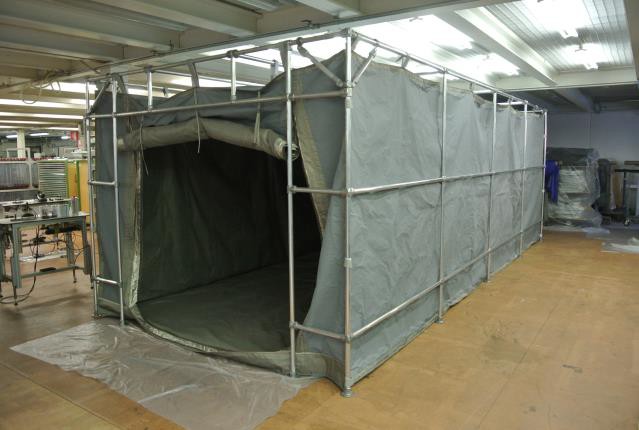
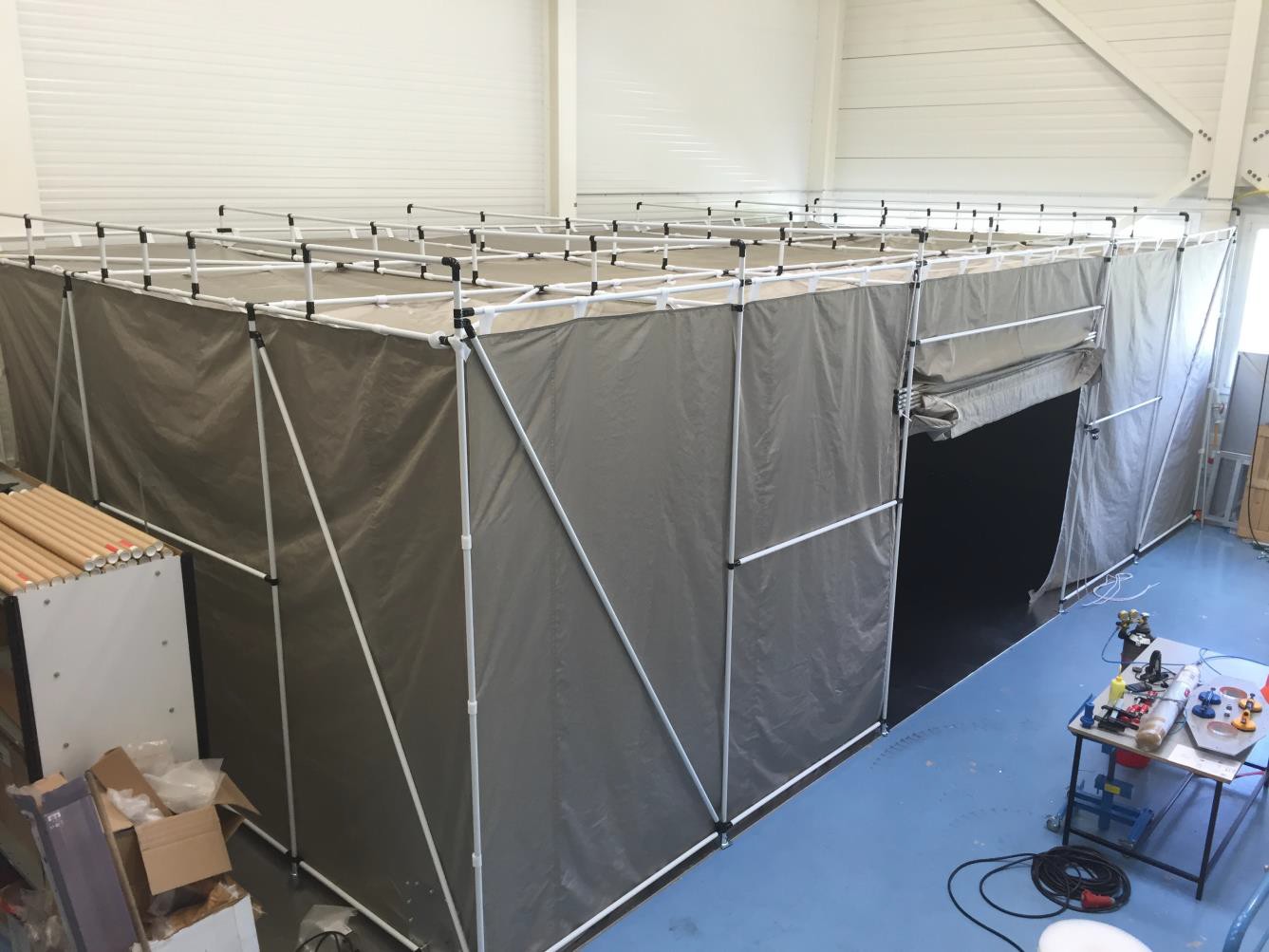
To ensure that the portable shielded test tent meets RF insulation requirements, the supplier's shielding performance data should be carefully analyzed to verify that they meet the minimum shielding requirements. SOLIANI EMC uses third party IEEE: 299-2006 tests to measure the minimum shielding effectiveness achieved on fully assembled enclosures at different locations in the tent at different frequencies. This test on a Soliani EMC high-attenuation tent with internal vestibule resulted in attenuation of at least -85.7 dB from 1 MHz to 18 GHz during taking measurements through the wall at multiple locations.
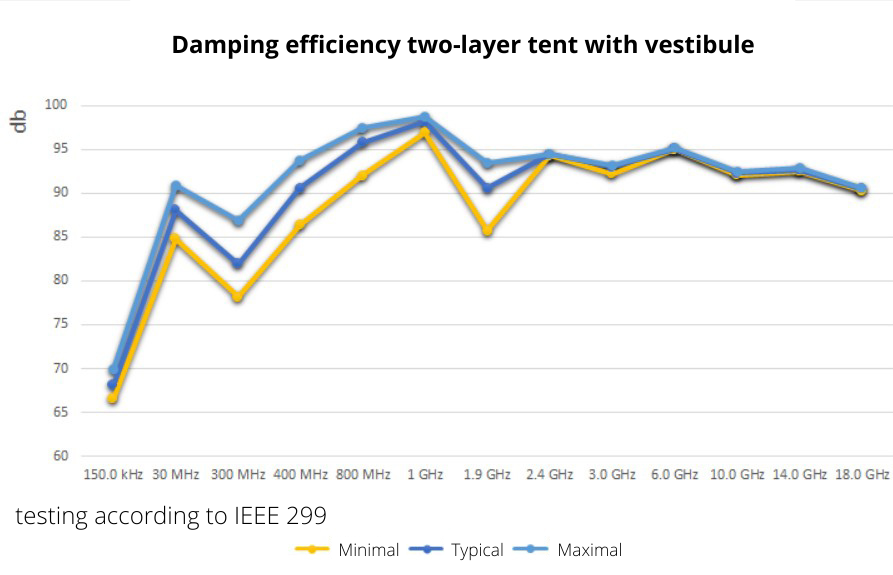
Specification
Made in Italy with metallized material in Italy.
Standard portable damping tent enclosures include:
- Multiple layers of Galileo conductive fabric
- White ESD fabric layer inside the tent (on request),
- Internal or external vestibule entry system,
- Single or double patented door sealing systems,
- Steel or inflatable frame,
- Efficient power and data filtering,
- Complete screened ventilation system,
- RF shielded floor between two layers of heavy duty tarpaulin,
- A bag for storing and transporting the tent,
- Full installation instructions.
Patented door system
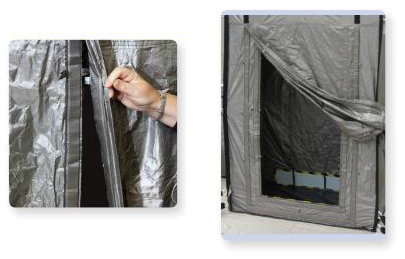
The exclusive, patented SOLIANI EMC door sealing system ensures insulation of the inner casing. The operations carried out inside the enclosure need not be interrupted when exiting and entering the tent. The patented single door sealing system includes a lightweight, easy-to-use double magnet closure that maximizes RF isolation and EMI shielding. Both internal and external doors are equipped with the exclusive SOLIANI EMC door system.
EMI / RFI screened tents are made of highly conductive, lightweight and very strong textile material. As standard, screened tents come with multiple ropes so they can be easily attached to the ceiling or they can be equipped with a free-standing rack.
Typical applications are EMC experiments, RF measurements, mobile military or forensic operations, and personal protection in the field. Faraday tents offer a mobile solution for a fraction of the cost of a conventional Faraday cage.
Mounting options

Applications
Automotive
The connectivity megatrend also continues in the commercial vehicle industry. Everyone wants and needs to be connected everywhere. To ensure this, the number of radio services and the use of their channels are increasing. However, the existing frequency bands were no longer sufficient, so we had to switch to slower higher frequencies. In addition to connectivity, the automotive industry also focuses on safety and seamless functionality , therefore the tested frequency range was extended from the Super High Frequency (SHF) range immunity test.
But as we know, the shading theme in the absorber hall grows with increasing frequency, while the transmission lobes of the measurement antennas decrease. However, more and more antenna positions are required as the frequency increases to ensure the desired test range. This is especially true for long and large vehicles.
The measurement method in the turbulence mode (MTC) chamber does not present this problem. Due to the desired reflections on the chamber walls, the test object is immediately exposed to the test field from all sides and directions due to the statistical homogeneity of the field.
Measurement
As you know, there are two different measurement options in one MTC. First, the "tuned mode" in which the stirring mode rotates step by step and then measures, and the "stirring mode" in which the mode is continuously rotated and measured simultaneously.
"Tuned Mode" requires, on the one hand, solid walls and a stirrer. On the other hand, the measuring process is very time-consuming as each stirrer position has to be measured and the decomposition time is required. This does not mean a time advantage over a few antenna positions and is therefore not of interest to the automotive industry.
W takim przypadku pozostaje „tryb mieszania”, w którym podczas pomiaru na badanym obiekcie ustawiane jest średnie natężenie pola. Średnia siła pola zależy od komory, mieszadła i samej próbki. Czysta kontrola wzmacniacza (otwarta pętla) za pomocą krzywych charakterystycznych wymagałaby czasochłonnej kalibracji. Dlaczego warto wybrać system o kontrolowanym natężeniu pola z 8 szybkimi sondami polowymi (zamknięta pętla).

Figure 1: Bus in the test field, field probe on the mast (1).
8 probes, see Figure 7 (1), span the test volume. They are placed on four PVC masts surrounding the vehicle. The distance to the vehicle should be & gt; 1 m and more than? / 4 below the frequency from the walls [6].
The antenna should not be aimed directly at the vehicle, but at the oscillating device behind the movable wall.

Figure 2: Truck in test field, specific test volume in columns is irradiated with LogPer antenna.
According to [7], a statistically homogeneous field dominates the VIRC test volume if the standard deviation (at f ≥ 400 MHz) of the field strength of all probes is less than σ = 3. The multi-probe measurement system used automatically reported this value, which meant that the calibration was not necessary.
Space and laboratory
When the equipment is too large or requires special conditions (loads, drives, water, emission of toxic fumes, etc.), testing in a typical semi-anechoic room may not be feasible. Temporary screen rooms consisting of a hardware cloth can be built around the test area to reduce the environment for radiation emission testing and limit the RF field during radiation susceptibility testing. Since the room can reflect light strongly, care should be taken to identify any resonances. Several antenna positions may be required to reduce the resonance effect.
Characteristics
- Semi-durable, easier to install, store and transport than metal wall chambers,
- Lower cost and weight than a permanently welded screened chamber,
- 10:1 weight ratio for welded room with screen,
- Removable "hardware cloth" panels,
- Inner frame,
- Attenuation over 70 dB in the range from 20 MHz to 18 GHz (IEEE ™ 299),
- Made of conductive Ni fabric covered with acrylic,
- Optional cleaning in accordance with ISO Class 7 (Class 10,000 -Fed. Std. 209).

Military
SOLIANI EMC RF insulated tents are designed for portable, secure communication * applications where specific signal attenuation is required. Our RF protective pouches are also designed to isolate wireless communication devices. Soliani EMC's engineering staff will also work with your team to design bespoke lightweight, foldable and secure RF security solutions to meet your requirements. SOLIANI EMC can secure your electronics including laptops, printers and communication devices, systems with RF Security portable table tents. Safe Tempest keyboards, high-damping power filtering and shielded RF windows allow full access to standard laptops.
SOLIANI EMC has worked with many government agencies providing RF security applications. RF isolation for police and emergency response agencies, transport security, including air and maritime transport, research into next-generation security technologies.

Registered with NATO
Registered with ITAR - US Department of State - Office of Defense Trade Compliance
Cage Code: A1040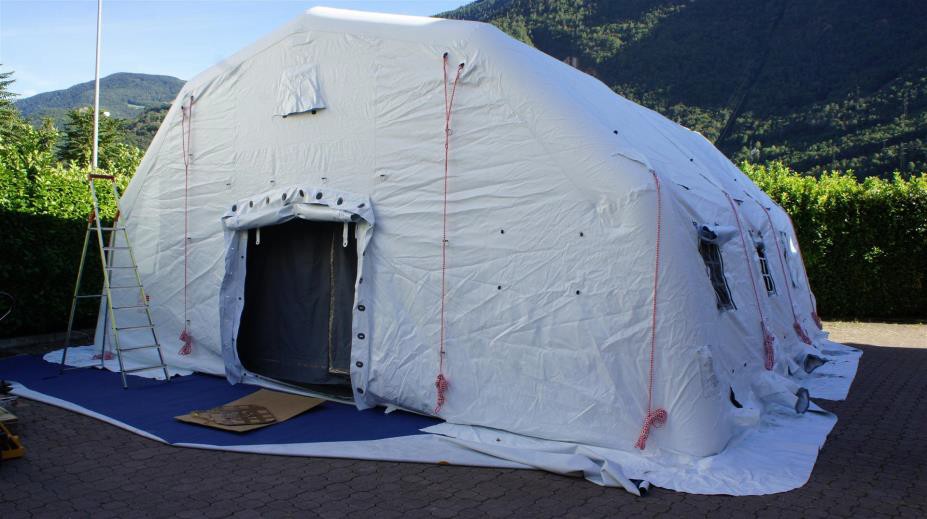
(*) RF isolation is part of a secure communication protocol. Make sure your operation complies with all sections of the protocol.
Related product
Related posts
 Now available – DC/DC converters from PREMIUM
Now available – DC/DC converters from PREMIUM
 New release in DACPOL lighting for lathes – Kira covers
New release in DACPOL lighting for lathes – Kira covers





Leave a comment